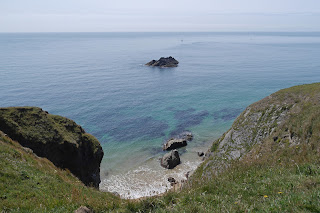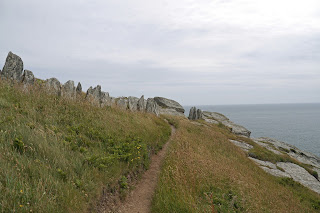Hope Cove
We set out from Hope Cove with quite a long section in prospect: 9.2 miles to the River Erme, one estuary where there is no ferry, although you can apparently walk across at low water. In between lies the inconvenient River Avon, where the ferry only runs 1000-1100 and 1500-1600.
We immediately made things worse by failing to spot a diversion sign affecting the path at nearby Thurlestone Sands, which meant we had to back-track before actually making the 1.5 mile detour inland to avoid a cliff-fall.
As we climbed up the hill away from the beach there was a good view back over the bay, with the arched Thurlestone Rock very prominent.
We now followed a low grassy headland path overlooked by Thurlestone Golf Course. This climbed quite steeply and then descended to reach the mouth of the Avon, with a lovely view across to Burgh Island. This is a tidal island connected to the mainland at Bigbury-on-Sea by a sandy strip. You can only walk over at low water. It is known for its links with Agatha Christie, who holidayed at the art deco hotel and set two novels there.
Carrying on down to almost sea level, there was a nice view along the Avon estuary.
We had solved the problem of the inconvenient ferry times by arranging for a taxi to meet us at the Sloop Hotel in Banham just along the river. Fast, if rather stressful, walking (we knew the driver had another fare booked soon after us), enabled us to reach Banham in time and we were whisked away to the other side of the river. From here we walked down to Bigbury-on-Sea, where we spotted another small, pretty and as yet unidentified, flower.
After a break for lunch at the Venus cafe, we headed uphill and away from Bigbury. There was another nice view of the island.
We passed through Challaborough, a rather poor cousin to Bigbury, with holiday homes and grey sand. Then we began a long climb to Toby's Point, which offered a welcome bench to sit on and fantastic views over the next, dramatic section of coast. We chatted to a chap who was already there, having walked up from Challaborough, and who seemed set to spend the afternoon there. He said he would watch us as we struggled on.
We began the descent to Aymer Cove, passing a rocky crest and noticing a strange black tower on the left at sea level.
The Cove itself had even more startling rock formations.
Now there was a steady climb, followed soon after by another steep descent, to Westcombe Beach and then an extremely steep climb to reach Holst Point. We actually went straight up the hill, only discovering at the top that there was a zig-zag path in the long grass which might have been easier.
The final section along the coast was easier - just as well! - and at one point there was a wonderful sense of the whole of Bigbury Bay. Bolt Head can be seen in the distance behind Burgh Island.
Along this section I saw two Painted Ladies, the first of the year. Now we turned Beacon Point and entered the unspoilt estuary of the River Erme.
We followed the estuary back to where we had left the car, at Wonwell Beach. The tide was just coming in - quite quickly it seemed. Perhaps we would have been in time to cross ...
Conditions: hazy cloud, with a threat of rain which fortunately did not materialise, but warm.
Distance: the best part of 11 miles in all, of which 9.2 count as forward progress. Distance now covered 194.3 miles.
Map: OL 20 South Devon.
Rating: Four and a half stars.












































